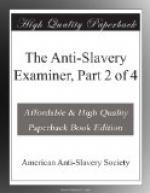the ground thrown up in ridges of about a foot high.
Then similar ridges are formed crosswise, with the
hoe, making regular squares of two-feet-sides over
the field. By raising the soil, a clear space
of six inches square is left at the bottom. In
this space the plant is placed horizontally,
and slightly covered with earth. The ridges are
left about it, for the purpose of conducting the rain
to the roots, and also to retain the moisture.
When we came up to the large company, they paused
a moment, and with a hearty salutation, which ran
all along the line, bade us “good mornin’,”
and immediately resumed their labor. The men
and women were intermingled; the latter kept pace
with the former, wielding their hoes with energy and
effect. The manager addressed them for a few
moments, telling them who we were, and the object
of our visit. He told them of the great number
of slaves in America, and appealed to them to know
whether they would not be sober, industrious, and
diligent, so as to prove to American slaveholders the
benefit of freeing all their slaves. At the close
of each sentence, they all responded, “Yes,
massa,” or “God bless de massas,”
and at the conclusion, they answered the appeal, with
much feeling, “Yes, massa; please God massa,
we will all do so.” When we turned to leave,
they wished to know what we thought of their industry.
We assured them that we were much pleased, for which
they returned their “thankee, massa.”
They were working at a job. The manager
had given them a piece of ground “to hole,”
engaging to pay them sixteen dollars when they had
finished it. He remarked that he had found it
a good plan to give jobs. He obtained
more work in this way than he did by giving the ordinary
wages, which is about eleven cents per day. It
looked very much like slavery to see the females working
in the field; but the manager said they chose it generally
“for the sake of the wages.”
Mr. B. returned with us to the house, leaving the
gangs in the field, with only an aged negro in charge
of the work, as superintendent. Such now is
the name of the overseer. The very terms,
driver and overseer, are banished from
Antigua; and the whip is buried beneath the
soil of freedom.
[Footnote A: In those cases where the plough is used at all. It is not yet generally introduced throughout the West Indies. Where the plough is not used, the whole process of holing is done with the hoe, and is extremely laborious]
When we reached the house we were introduced to Mr. Watkins, a colored planter, whom Mr. B. had invited to breakfast with us. Mr. Watkins was very communicative, and from him and Mr. B., who was equally free, we obtained information on a great variety of points, which we reserve for the different heads to which they appropriately belong.
FITCH’S CREEK ESTATE.




